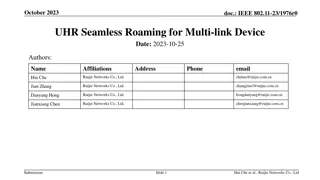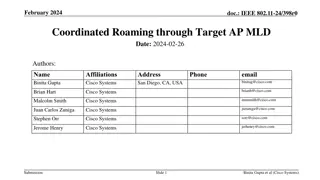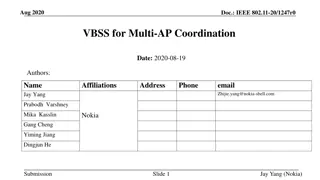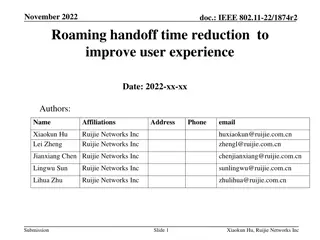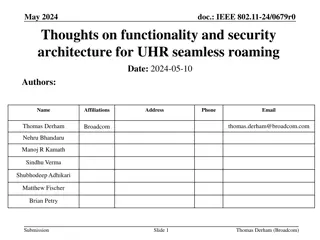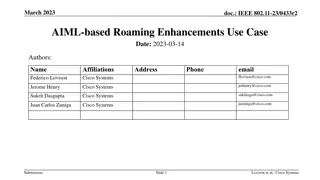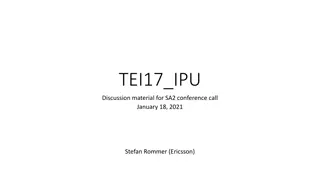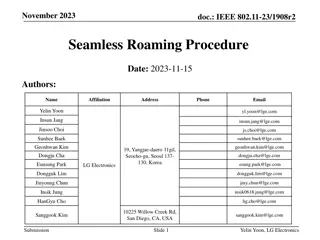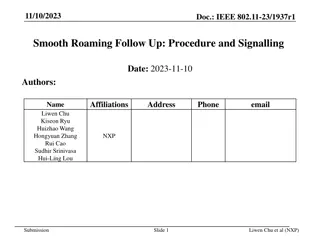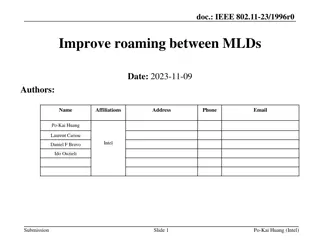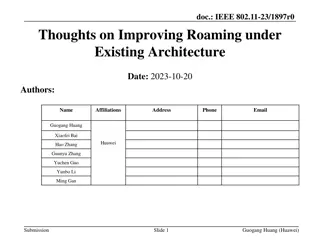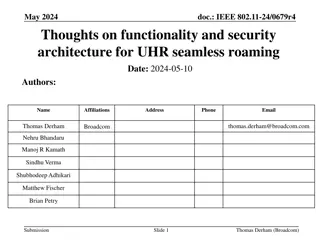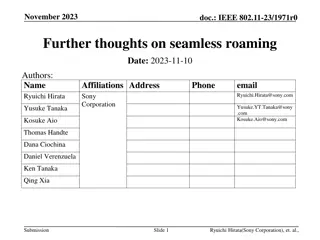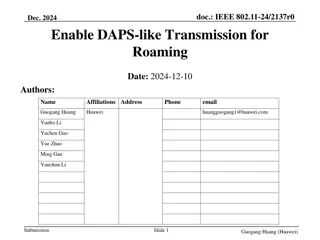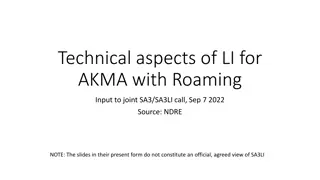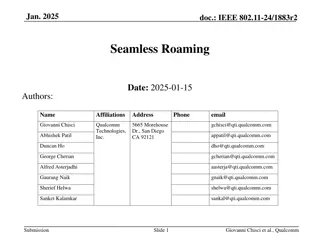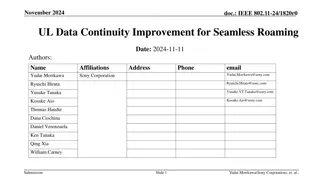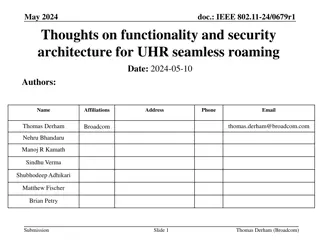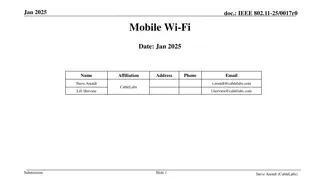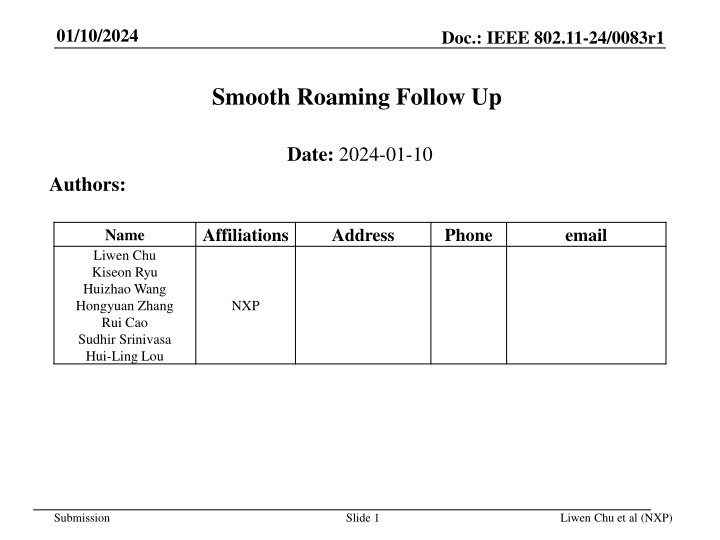
IEEE 802.11-24/0083r1: Roaming AP MLD in Wireless Networking
Explore the intricacies of IEEE 802.11-24/0083r1 regarding Roaming AP MLD in wireless networks. Learn about smooth roaming support, MLD level features, and the distinction between AP MLD and Roaming AP MLD. Discover the essential elements for seamless roaming and the significance of MAC agreements in the context of wireless communication.
Download Presentation

Please find below an Image/Link to download the presentation.
The content on the website is provided AS IS for your information and personal use only. It may not be sold, licensed, or shared on other websites without obtaining consent from the author. If you encounter any issues during the download, it is possible that the publisher has removed the file from their server.
You are allowed to download the files provided on this website for personal or commercial use, subject to the condition that they are used lawfully. All files are the property of their respective owners.
The content on the website is provided AS IS for your information and personal use only. It may not be sold, licensed, or shared on other websites without obtaining consent from the author.
E N D
Presentation Transcript
01/10/2024 Doc.: IEEE 802.11-24/0083r1 Smooth Roaming Follow Up Date: 2024-01-10 Authors: Affiliations Address Phone email Name Liwen Chu Kiseon Ryu Huizhao Wang Hongyuan Zhang Rui Cao Sudhir Srinivasa Hui-Ling Lou NXP Submission Slide 1 Liwen Chu et al (NXP)
01/10/2024 Doc.: IEEE 802.11-24/0083r1 Recap: Roaming AP MLD Roaming AP MLD for smooth roaming support includes multiple AP MLDs. Roaming AP MLD support is optional at UHR non-AP MLD side. Roaming AP MLD is not visible to EHT non-AP MLDs and UHR non-AP MLDs without roaming support. A MAC SAP address is defined for a roaming AP MLD. The BA agreement is negotiated between an UHR non-AP MLD and the roaming AP MLD if the UHR non-AP MLD supports the roaming. The PMKSA, PTK of an UHR non-AP MLD are negotiated between an UHR non-AP MLD and the roaming AP MLD. Some non-link level MAC features are at MLD level while the other non-link level MAC features are at roaming MLD level. Two types of roaming are MLD level roaming and optional Link level roaming. In a roaming AP MLD, a non-AP MLD is identified by AP MLD roaming ID + AID where AID is defined by AP MLD. The link of roaming AP MLD is identified by AP MLD roaming ID + Link ID where Link ID is defined by AP MLD. The MLD level features being separated between MLD level and roaming AP MLD level are discussed. The new Basic ML element, updated BTM and MLD reconfiguration are used for smooth roaming. Roaming AP MLD common MAC Roaming AP MLD1 Visible to an EHT non-AP MLD and UHR non-AP MLD without roaming support AP MLD14 AP MLD12 AP MLD13 AP MLD11 MLD common MAC MLD common MAC MLD common MAC Visible to an UHR non-AP MLD support roaming MLD common MAC 6GHz AP142 5GHz AP121 5GHz AP131 5GHz AP141 6GHz AP112 6GHz AP132 6GHz AP122 5GHz AP111 Submission Slide 2 Liwen Chu et al (NXP)
01/10/2024 Doc.: IEEE 802.11-24/0083r1 AP MLD Level vs Roaming AP MLD Level Features The roaming AP MLD level features are The features related to discovery, ML setup, roaming, the information that doesn t change when the serving AP MLD is changed, Features related to frame exchange context existed at the current serving AP MLD, The other features are AP MLD level features. the information on roaming AP MLD level may be at the location common to all AP MLDs, e.g. the distribution of the individually addressed data frames of a non-AP MLD to the current serving AP MLD of the non-AP MLD. Otherwise, the information except discovery and ML setup needs to be transferred to the target serving AP MLD. Submission Slide 3 Liwen Chu et al (NXP)
01/10/2024 Doc.: IEEE 802.11-24/0083r1 AP MLD Level vs Roaming AP MLD Level Features The following features are roaming MLD level features: Discovery ML setup ML reconfiguration if the roaming from the current serving AP MLD to the new serving AP MLD is done through ML reconfiguration BSS transition management if it is used for recommending the new serving AP MLD Multi-Link power management maximal idle period Proxy ARP For EPCS at least the authority result of non-AP MLD s usage of EPCS. As a general rule, all the services that need the authority of the outside server are roaming MLD level features. Block Ack This is useful when the reorder buffer, transmit window are transferred from the current roaming AP MLD to the new serving AP MLD. Individual-addressed frame delivery without BA agreement PMK, PTK, PN The last three items will be further discussed in the following slides. Submission Slide 4 Liwen Chu et al (NXP)
01/10/2024 Doc.: IEEE 802.11-24/0083r1 MLD Level vs Roaming MLD Level MLD Features The following features are MLD level features: Link management TID-to-Link mapping, link disable/enable, link recommendation BSS parameter critical update Multi-Link power management except maximal idle period Buffer frame indication, listen interval, WNM sleep mode, power state etc. Group-addressed frames Management frames Multi-link medium access STR, NSTR, medium access recovery etc. EMLSR, EMLMR Submission Slide 5 Liwen Chu et al (NXP)
01/10/2024 Doc.: IEEE 802.11-24/0083r1 Frame Exchange Context from Current Serving AP MLD to New Serving AP MLD Frame exchange context for DL frame transmission (Tx) PTK, PN for unicast Data frames. Next SN being used (SN space) for unicast QoS Data frames of each TID addressed to the non-AP MLD that does the smooth roaming. Submission Slide 6 Liwen Chu et al (NXP)
01/10/2024 Doc.: IEEE 802.11-24/0083r1 Frame Exchange Context from Current Serving AP MLD to New Serving AP MLD Frame exchange context for UL frame transmission (Rx) PTK (same as PTK in Tx part), Replay Counters for unicast Data frames; One replay counter for unicast QoS Data frames each TID, The duplicate detection cache for unicast QoS Data frames of each TID from the non-AP MLD that has no BA agreement. Submission Slide 7 Liwen Chu et al (NXP)
01/10/2024 Doc.: IEEE 802.11-24/0083r1 UL TID with BA Agreement The BA reorder buffer of the current serving AP MLD (the frames in reorder buffer that can t be sent to up layer) may be moved to the new serving AP MLD or may not be moved to the new serving AP MLD. A non-AP MLD needs to know how the roaming AP MLD process the BA reorder buffer. If the new serving AP MLD acquires the reorder buffer information of the current serving AP MLD, the WinStartB in the new serving AP MLD will be the same as the WinStartB of the current serving AP MLD. The discarding of the frames in Transmit Buffer may create unnecessary frame discarding. Submission Slide 8 Liwen Chu et al (NXP)
01/10/2024 Doc.: IEEE 802.11-24/0083r1 UL TID with BA Agreement If the new serving AP MLD has no the reorder buffer information of the current serving AP MLD, the WinStartB in the new serving AP MLD will be the SN that is not less than the largest sequence number of the frame that is sent to the upper layer for the further processing. The retransmission of the frames whose sequence numbers are less than WinStartB of the new serving AP MLD will be discarded by the new serving AP MLD after roaming to the new serving AP MLD. The new serving AP MLD notifies the non-AP MLD the WinStartB of each UL TID with the BA agreement. The non-AP MLD uses the WinStartB as its WinStartO. The new serving AP MLD flushes its scoreboard context for the non-AP MLD. Submission Slide 9 Liwen Chu et al (NXP)
01/10/2024 Doc.: IEEE 802.11-24/0083r1 DL TID with BA Agreement It is up to the roaming AP MLD to decide whether the transmit buffer control (frames in transmit buffer) is moved from the current serving AP MLD to the new serving AP MLD. The new serving AP MLD may notify the non-AP MLD its WinStartO. The non-AP MLD uses the WinStartO to update its WinStartB and WinStartR. Another variant is that the BAR is used for such operation. Submission Slide 10 Liwen Chu et al (NXP)
01/10/2024 Doc.: IEEE 802.11-24/0083r1 NSTR Link Pair for Links associated with Two Serving AP MLDs For link level roaming, the two links temporally associated with two serving AP MLDs may be NSTR link pair. In 11be, when two APs of an AP MLD transmit PPDUs to a non-AP MLD simultaneously through two links of a NSTR link pair, the two PPDUs need to stop at the same time. This may not be easy to do when two APs belong to tow serving AP MLDs. Solution: A non-AP MLD notifies the two serving AP MLDs that its two links associated with the two serving AP MLDs are NSTR link pair. When a serving AP MLD intends to use one link of a NSTR link pair to do frame exchanges with the non-AP MLD that announces the NSTR link pair with two serving AP MLDs, the serving AP MLD (related AP in the link) needs to start its TXOP by using (MU-)RTS/CTS frame exchange. If the non-AP MLD does the frame exchanges with one serving AP MLD through one link of a NSTR link pair and receives a (MU-)RTS in another link of the NSTR link pair from another serving AP MLD, the non-AP MLD will not respond with the CTS. The requirement of stopping the two PPDUs at the same time is relaxed. Submission Slide 11 Liwen Chu et al (NXP)
01/10/2024 Doc.: IEEE 802.11-24/0083r1 MLSR non-AP MLD with Two Serving AP MLDs When a MLSR non-AP MLD is associated with two serving AL MLDs at the same time, the two serving AP MLD can t transmit the PPDUs to the MLSR non-AP MLD at the same. Solution: A non-AP MLD notifies the two serving AP MLDs that it is MLSR non-AP MLD. the non-AP MLD negotiates the individual TWT agreements for two MLSR links with two serving AP MLDs where the individual TWT agreements in two links don t overlap with each other in time domain. The STAs of the MLSR non-AP MLD are in power save mode. Submission Slide 12 Liwen Chu et al (NXP)
01/10/2024 Doc.: IEEE 802.11-24/0083r1 EMLSR/EMLMR non-AP MLD with Two Serving AP MLDs When an EMLSR/EMLMR non-AP MLD is associated with two serving AL MLDs at the same time, one serving AP MLD can t initiate the frame exchange in one EMLSR/EMLMR link when another AP MLD is doing the frame exchanges in another EMLSR/EMLMR link. Solution : A non-AP MLD notifies the two serving AP MLDs that it is EMLSR/EMLMR non-AP MLD. The requirement of no initiating frame exchange in one EMLSR/EMLMR link when doing frame exchanges in another EMLSR/EMLMR link at the same time is relaxed. Submission Slide 13 Liwen Chu et al (NXP)
01/10/2024 Doc.: IEEE 802.11-24/0083r1 Summary The feature separation between roaming AP MLD level and AP MLD level is discussed. The information of the features at roaming AP MLD that is not stored at a common location needs to switch from the current roaming AP MLD to the new serving AP MLD. The information for Data, Management frame exchange. The service agreed by the serving AP MLD and still provided in the new serving AP MLD. The medium access with the links associated with two AP MLDs during roaming is discussed: The processing of NSTR/MLSR/EMLSR/EMLMR link pair connected with the current serving AP MLD and the new serving AP MLD. Submission Slide 14 Liwen Chu et al (NXP)

